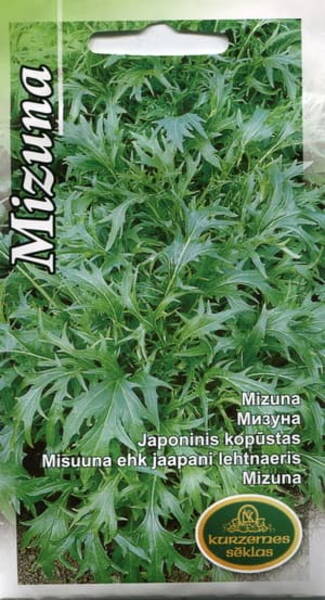Ex Tax: 1.10€
A worthy competitor to spinach in salads.
Mizuna is an ultra-early, highly productive, lettuce vegetable crop, for growing in open and protected ground. Strongly dissected, dark green leaves form a large rosette of leaves (30-40 pieces).
The taste qualities are excellent. Superbly grows after cutting, which makes it possible to harvest throughout the summer-autumn period. It is intended both for fresh consumption and in salads, frozen.
Agrotechnics.
Good predecessors are legumes, cucumber, potatoes. You can not grow cabbage after other vegetable crops of the same family - radish, turnip, radish, swede, turnip, watercress. The optimal reaction of the soil environment is pH 6.5-7.2.
The culture is cold-resistant, the seeds sprout already at +3 + 4 ° C, and seedlings are able to tolerate frosts down to -4 ° C. It can be sown in several stages, starting from the end of April (when the soil warms up to +10 °C) and until the end of August.
Sowing seedlings is carried out in mid-March. Seedlings dive 7-10 days after germination. Seedlings are ready for planting 35-40 days after germination. They plant it at the end of April according to the scheme 35x50 cm.
Further care consists in watering, weeding, loosening and regular feeding. For top dressing, a complex fertilizer is used (contains the NRK complex enriched with a wide range of trace elements), which provides the necessary nutrition for vegetable crops.
Japanese cabbage seeds are rather small, dark gray, slightly larger than a poppy seed.
1.0 g = 500 seeds.
The recommended shelf life of seeds is 3 years.
The optimum sowing depth is 0.5 cm.
Eng.: Japanese mustard. Bot. syn.: Brassica rapa ssp. nipposinica var. laciniata, Brassica rapa var. lancinifolia.
* Japanese mustard Mizuna - a real exotic, is the least known among cabbages. It is grown mainly in Japan and on the Pacific coast of China.
In its biochemical composition, it is not much different from Beijing and Chinese cabbage. At the same time, it is Japanese cabbage that contains the least mustard oils, which give cabbage plants a specific taste and aroma.
This cabbage grows a little slower than Beijing and Chinese.
Since the leaves contain less mustard oil than Beijing and Chinese cabbage, Japanese cabbage is even more useful for cardiovascular diseases and stomach ulcers.
It is mainly eaten fresh for salads, sandwiches, and decoration of dishes.












